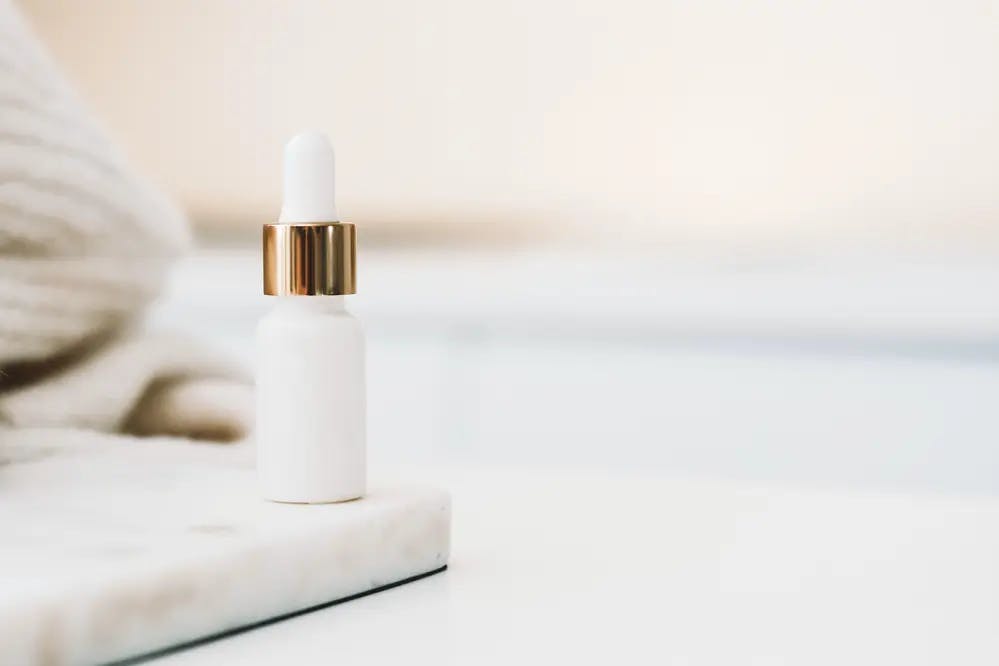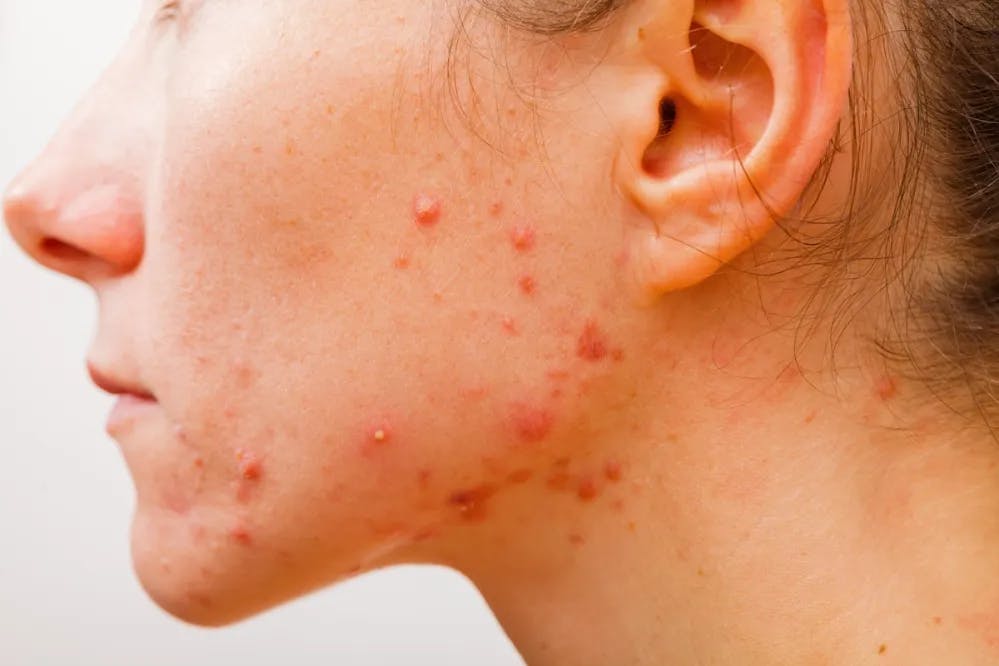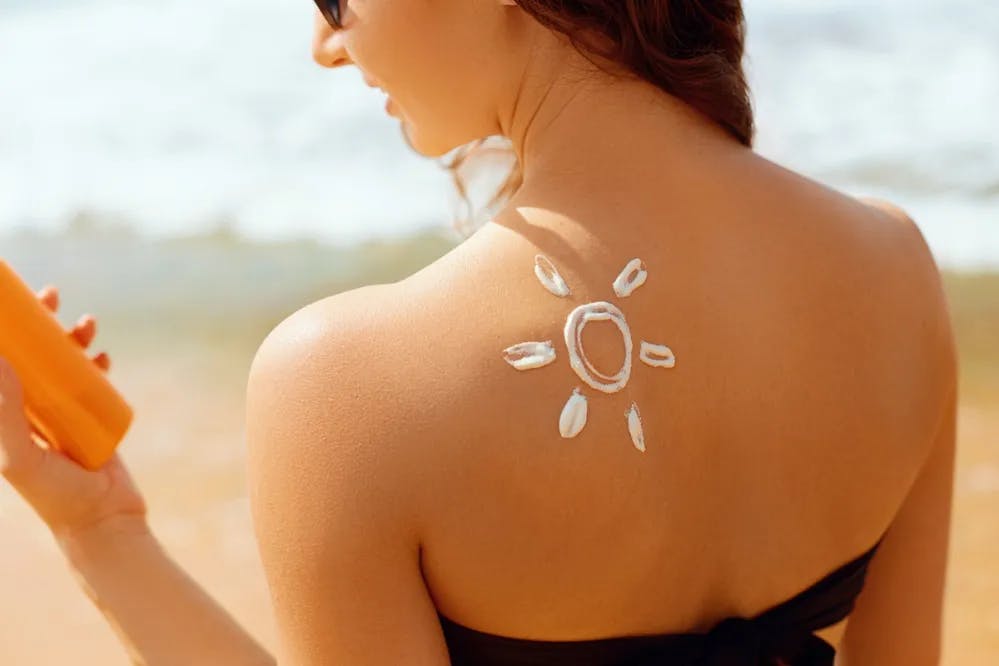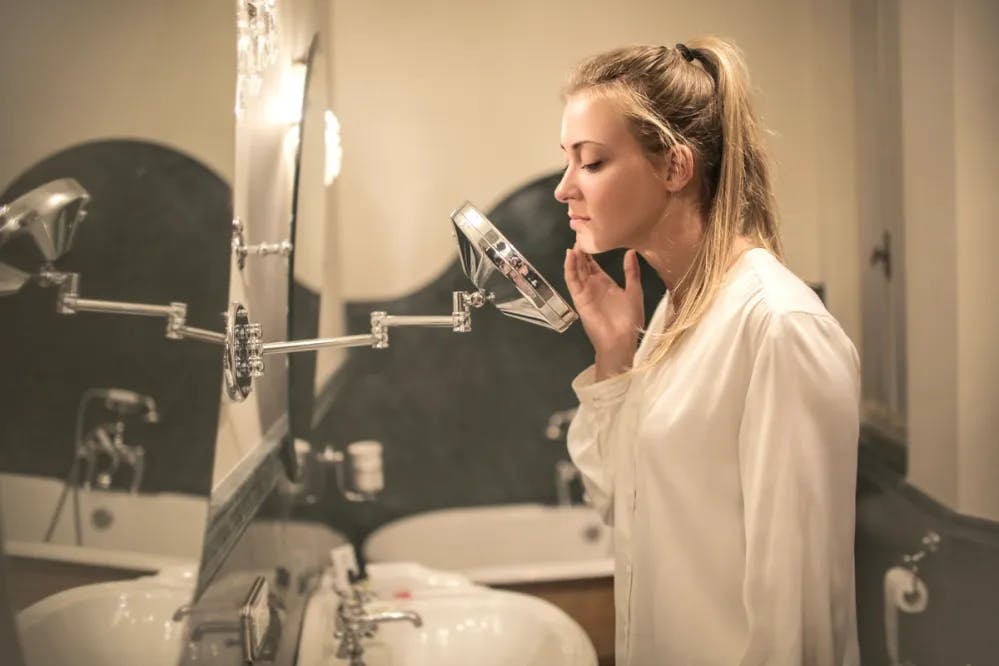Chest Acne: Causes and Treatments, And How it Differs From Facial Acne
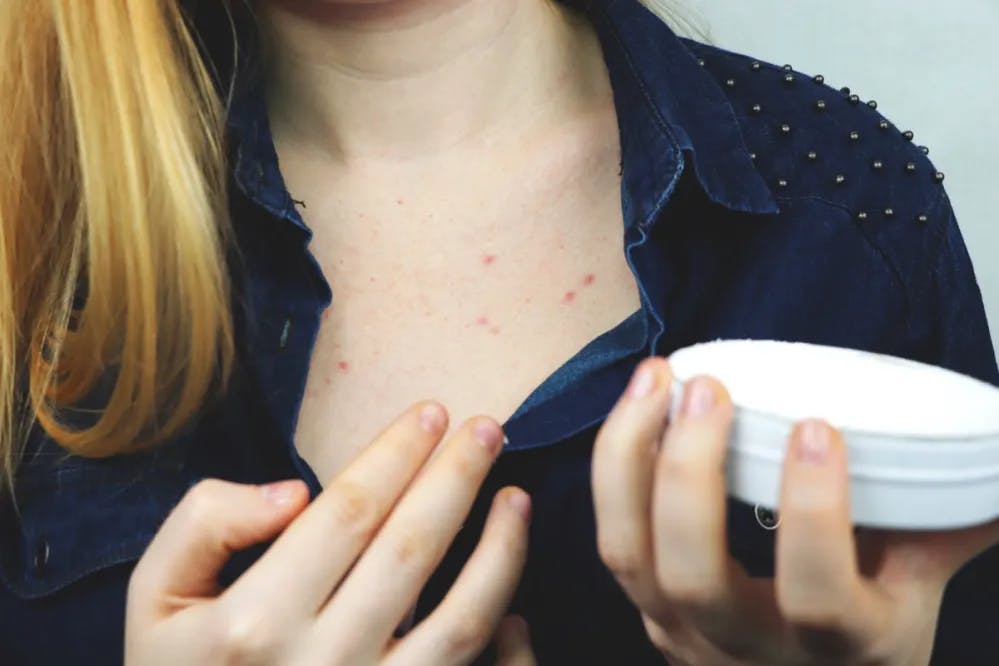
Table of Contents:
- So, What is Chest Acne, Anyway?
- The Difference Between Facial Acne and Body Acne
- What Causes Back and Chest Acne?
- Are You Sure It’s Acne? Folliculitis, Rosacea, and Other Conditions
- Body Acne Treatments: How to Get Rid of Chest Acne and Back Acne
- Shower and Exfoliate Often
- Change Your Clothing
- Clean Up Your Diet
- Use Good Sunscreen
- Conclusion
Acne can appear on any part of your body. In fact, if you suffer from facial acne, it’s likely you might also see pimples occur on your chest, your back, or your arms.1
In this article, we will go through the most common causes of body acne. We will also explain other conditions that can be mistaken for it and show you how to change your routine to get rid of those irritating back and chest pimples.
So, What is Chest Acne, Anyway?
Chest acne (and body acne in general) is usually caused by clogged pores. When an excess of sebum, typically due to hormones increasing its production, gets combined with debris and dead skin cells, it causes blockages. Then, if these blocked pores (which appear as blackheads and whiteheads) get inflamed and become infected with the Cutibacterium acne bacteria, they create inflamed, red bumps or pimples.2
This process can happen on any part of your body, but some areas, like your chest and back, will have more exposure to sweat, fabric friction, and processes like hair removal, epilation, and waxing. The cause, however, is the same regardless of where your acne is: There is an increase in sebum production, the propionibacterium (a type of gram-positive anaerobic bacteria) acnes colonize the area, the skin pores get blocked, and this produces inflammation.
The Difference Between Facial Acne and Body Acne
Both facial acne and body acne have the same broad cause: Clogged pores (in dermatology, they come under one clinical term called “Truncal Acne”). However, the pimples on your chest and back might have more severe breakouts because, in these areas, sweat can become trapped between the skin and the fabric and it can’t evaporate (something that does happen on the face). This type of acne, caused by friction and pressure on the skin, is called ‘acne mechanica.’.
In short, both are almost the same, but they just differ because of your body’s physiology; your back and chest areas have thicker skin and secrete more sebum. Plus, back or chest acne tends to be ignored because there aren’t as many products that focus on these zones, and it can be harder to exfoliate and moisturize them.
What Causes Back and Chest Acne?
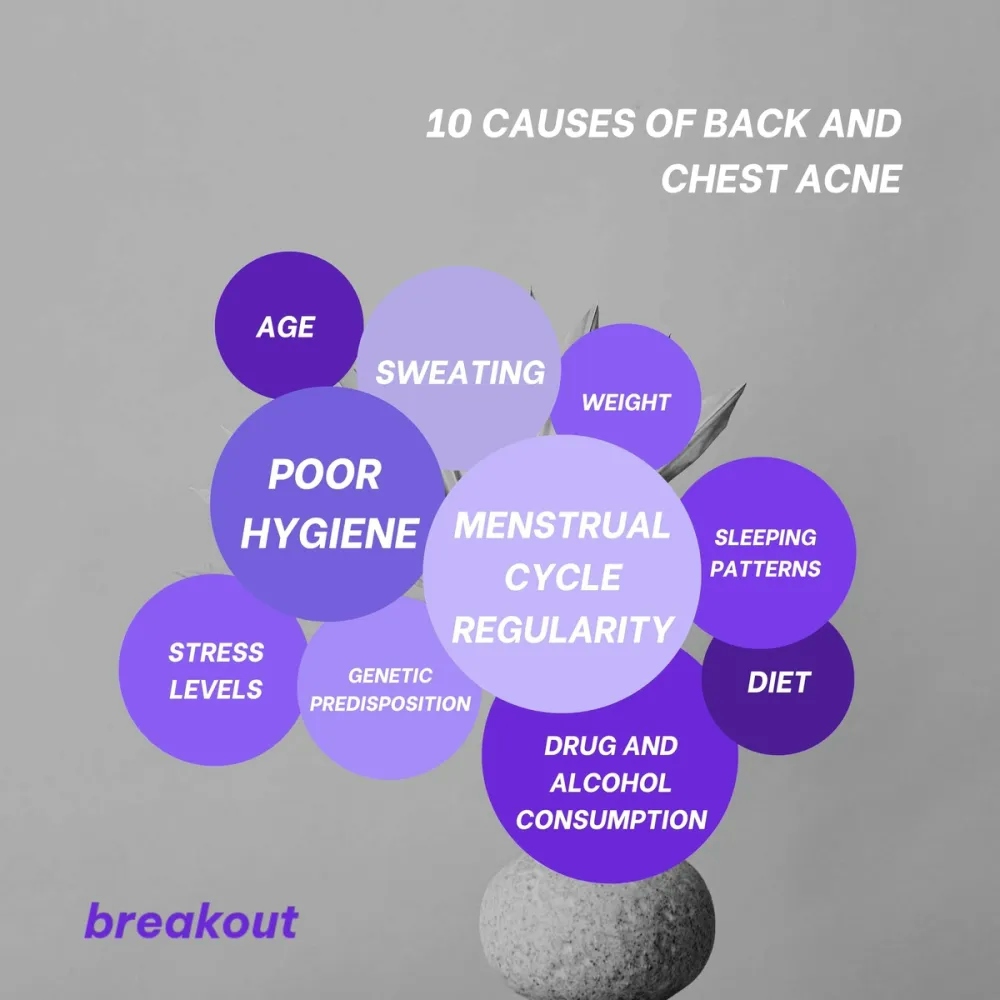
The most common causes of body acne are:
- Poor hygiene (dirt, debris, and dust can all clog your pores if they stay longer on your face)
- Sweat (also clogging, especially when combined with friction and heat)
- Age (certain hormonal changes, particularly trigger during adolescence, can cause the skin to produce more oil)
- Unhealthy dietary habits (like eating too much sugar and carbohydrates)
- Stress (your body can release stress hormones, like cortisol and androgens, that increase your skin’s oil production)
- Menstrual cycle irregularities (hormones fluctuate during the menstrual cycle, potentially triggering breakouts)
- Drug and alcohol consumption (drinking alcohol can affect certain bodily systems and change your hormone levels)
- Genetic predisposition (some people inherit genetic components that make them acne-prone and/or create a stronger inflammatory response to bacteria)
- Irregular sleeping patterns (a lack of sleep can cause stress, spiking your cortisol and leading to increased production of sebum)
Are You Sure It’s Acne? Folliculitis, Rosacea, and Other Conditions
There are a few conditions that can be mistaken for acne, so it’s important to keep these in mind before you seek treatment for pimples on your back, chest, or any other part of your body.3 For instance:
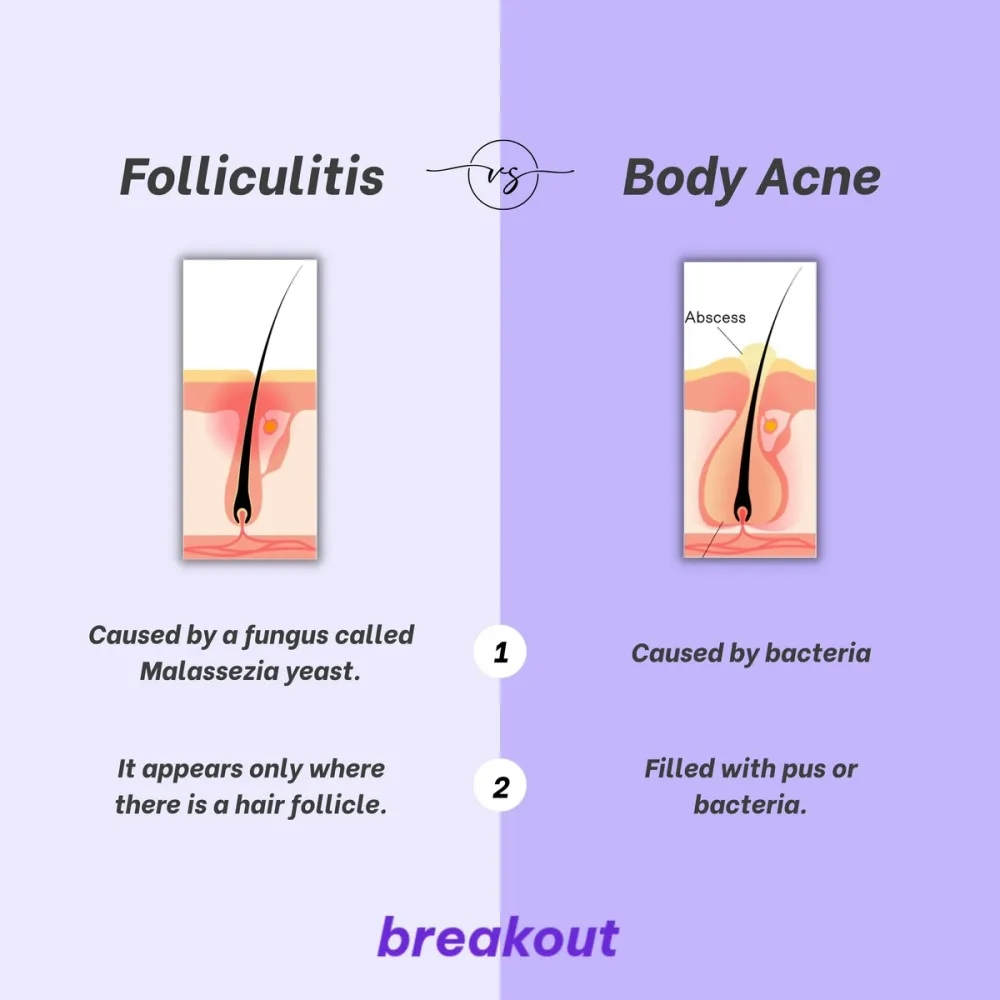
- Body Acne vs. Keratosis Pilaris: Keratosis Pilaris is a skin condition that causes small bumps and dry, rough patches of skin. However, unlike acne, these bumps are not filled with pus or bacteria.
- Body Acne vs. Rosacea: Although both acne and rosacea cause bumps and redness, the second tends to cover a larger area and has fewer blackheads and clogged pores.
- Body Acne vs. Folliculitis: Folliculitis is a common skin condition that occurs when there’s an inflammation of skin follicles due to a bacterial infection. The result is small pimples that appear where each hair grows.
- Body Acne vs. Fungal acne: Fungal acne, also called Malassezia Folliculitis or Pityrosporum Folliculitis, is an infection caused not by bacteria but by a fungus that causes clusters of small red bumps on your skin. You can get rid of them using antifungal medication.
Body Acne Treatments: How to Get Rid of Chest Acne and Back Acne
You can get rid of the pimples on your back, chest, or arms by making a few easy lifestyle changes or trying topical treatments or oral medication.4,5
In terms of topical treatments, the most common products include those with benzoyl peroxide, retinoids, and topical antibiotics (such as erythromycin and clindamycin). Oral medication tends to be restricted to antibiotics administered by a physician. A dermatologist can help you find the exact cause of your body acne, explain the triggers, and recommend the best medication for your case.
The best thing you can do to get rid of chest acne in the long term is to make some adjustments to your lifestyle.
Shower and Exfoliate Often
Your back is constantly exposed to different fabrics and sweat, both of which can carry debris capable of blocking your pores. It’s best to shower daily, to keep your chest and back free from debris. Regardless of skin type, exfoliating is also a great idea to clean any surface debris. To do this, you can use chemical exfoliants (such as glycolic acid and salicylic acid) or physical options like textured cloths and scrubs containing abrasives like jojoba beads. Make sure you replace your personal hygiene products on a regular basis, as they can grow bacteria.
Change Your Clothing
When possible, use natural fibers and loose-fitting clothes (especially during the hotter, more humid months). Change your tops as soon as you’re done exercising. If you need to wear a backpack for long periods of time, consider adding an alternative to your routine, such as a messenger bag, shoulder bag, or tote.
If you have back acne, avoid using backpacks for long periods of time.
Clean Up Your Diet
An unhealthy diet can be a trigger for body acne, especially ones containing foods high in glycemic index (GI), which can make your blood sugar rise quickly. Try to replace pasta, bread, and rice with veggies, fruits, whole grains, and lean proteins and cut down on oily food consumption (especially junk food).6
Use Good Sunscreen
Sunscreen is essential if you’re out in the sun, but if you suffer from chest acne or back acne, you should make sure the product you’re using is not greasy, as it can clog your pores. Choose instead oil-free sunscreen that feels light on the skin.
Conclusion
Body acne and facial acne have the same causes (a build-up of oil and dead skin cells that gets infected with the acne bacteria), but they differ in how they need to be treated.
The severity of your acne will depend on its location in your body. You should always make sure you’re dealing with acne and not a similar condition such as rosacea or folliculitis. Back and chest acne is treatable and can usually be dealt with using home treatments and making some simple routine changes.
If you need a little extra support, there are different treatments available, such as acne cleaners, topical retinoids, and OTC or prescription medications.
Do you want to talk about more skincare topics like this? Join our community!
References:
- Poli, F.; Auffret, N.; Leccia, M.-T.; Claudel, J.-P.; Dréno, B., Truncal acne, what do we know? Journal of the European Academy of Dermatology and Venereology 2020, 34 (10), 2241-2246.
- Downie, M.; Guy, R.; Kealey, T., Advances in sebaceous gland research: potential new approaches to acne management. Inter. J. of Cosmet. Sci 2004, 26 (6), 291-311.
- James, W. D.; Elston, D.; Berger, T., Andrew's diseases of the skin E-book: clinical dermatology. Elsevier Health Sciences: 2011.
- Fox, L.; Csongradi, C.; Aucamp, M.; Du Plessis, J.; Gerber, M., Treatment modalities for acne. Molecules 2016, 21 (8), 1063.
- Kanlayavattanakul, M.; Lourith, N., Therapeutic agents and herbs in topical application for acne treatment. Inter. J. of Cosmet. Sci 2011, 33 (4), 289-297.
- Spencer, E. H.; Ferdowsian, H. R.; Barnard, N. D., Diet and acne: a review of the evidence. Int. J. Dermatol. 2009, 48 (4), 339-347.
